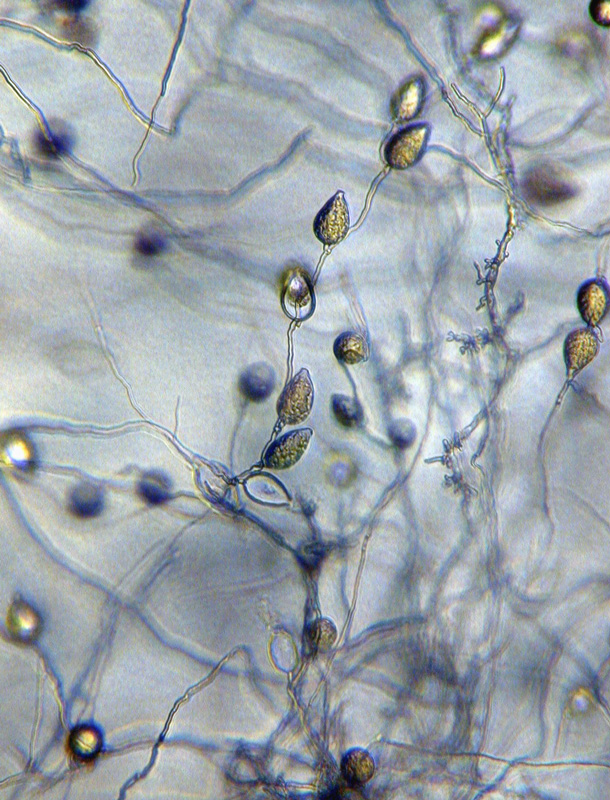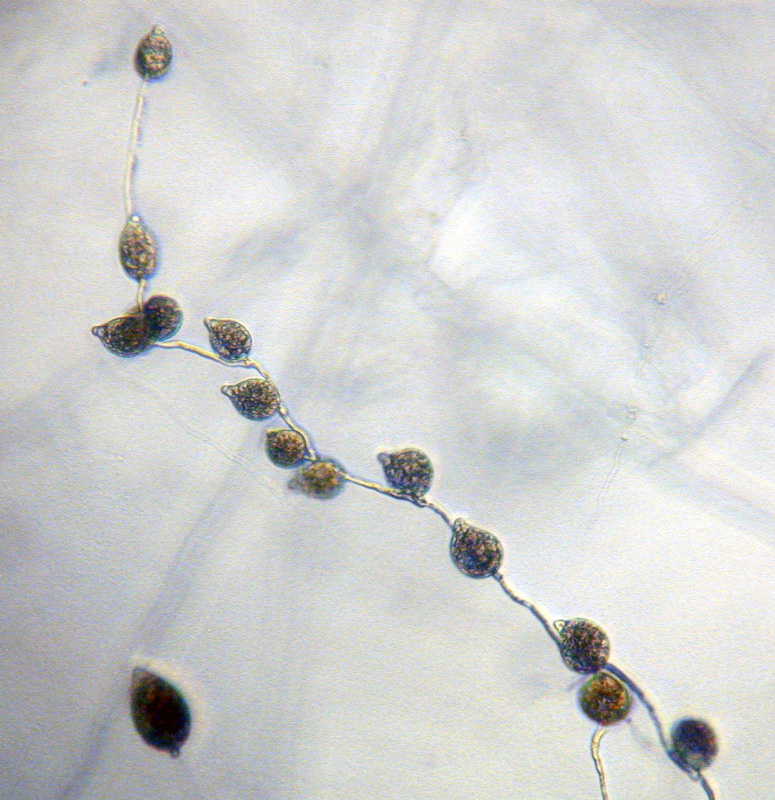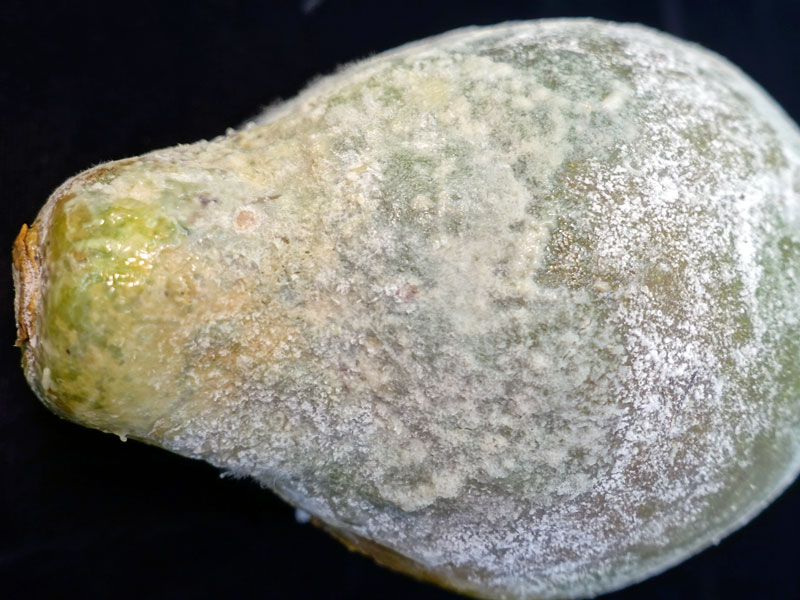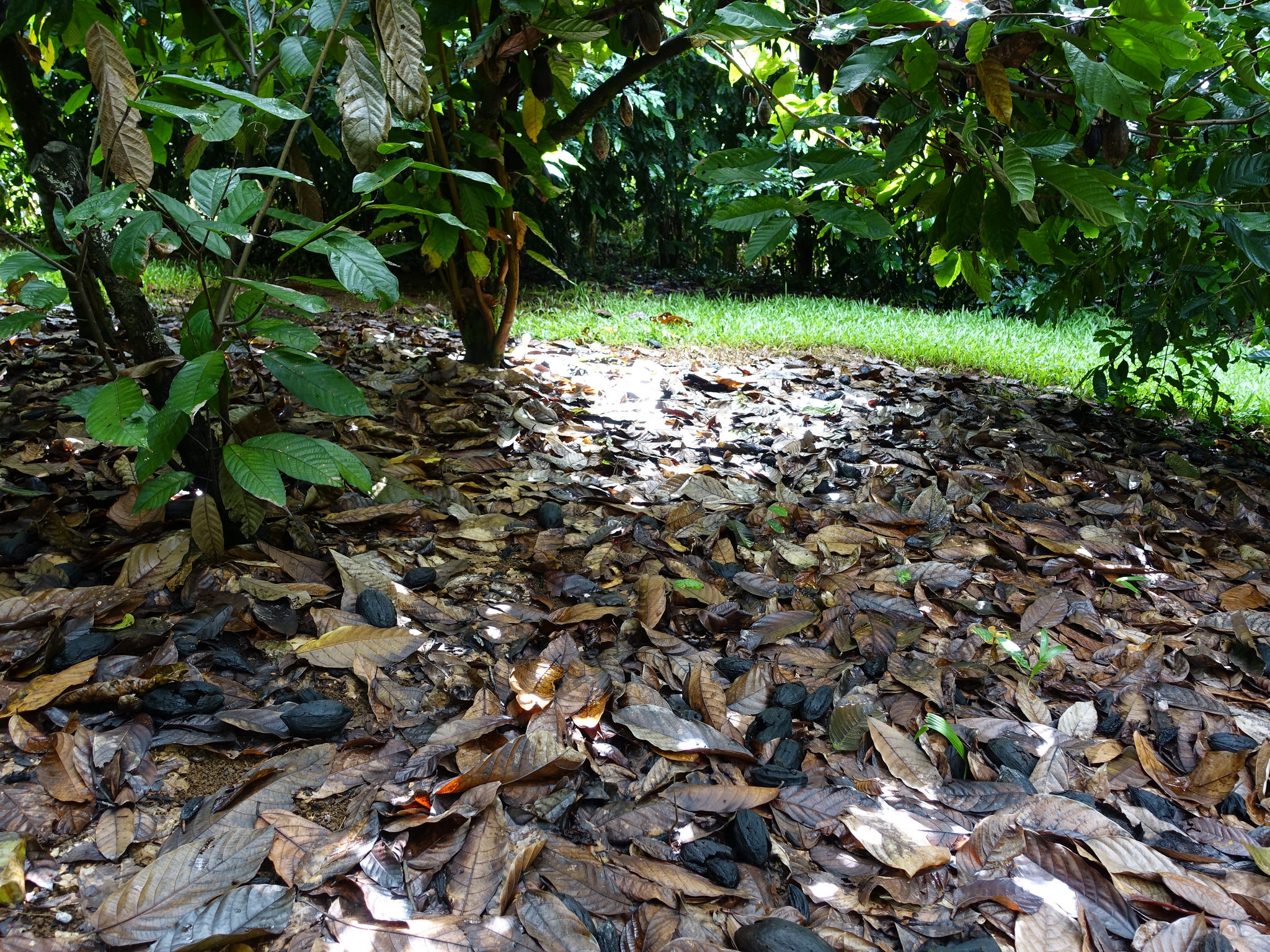Phytophthora palmivora (in progress - Abad et al. 2023b)
|
Phytophthora spp. in Clade 4: portion of the seven-loci ML phylogeny featuring the type cultures of 212 described species (by T. Bourret). Notice the position of P. palmivora selected specimen CBS 305.62 = S&T BL 105. Gloria Abad, USDA S&T.
|
|
Phytophthora spp. in Clade 4: Morphological Tabular key (PDF) and Tabular key legends (PDF) in IDphy2 KEY SECTION. Notice the data of P. palmivora selected specimen CBS 305.62 = S&T BL 105. Gloria Abad, USDA S&T.
|
|
Phytophthora palmivora (CPHST BL 105) colonies of the selected specimen #1 grown for 7 days on (a) V8® Agar, (b) potato dextrose agar, and (c) malt extract agar; photo by Krysta Jennings and Leandra Knight, USDA-APHIS-PPQ |
|
Phytophthora palmivora sporangia borne on simple sympodial sporangiophores |
|
Phytophthora palmivora chlamydospores |
|
Phytophthora palmivora sporangia borne on simple sympodial sporangiophores |
|
black pod rot of cacao (Theobromae cacao), caused by Phytophthora palmivora in Papaikou, Hawaii; watch: youtu.be/vgiSu8_M-xU; photo and video presentation by Scot Nelson, University of Hawaii at Manoa |
|
Phytophthora palmivora symptoms on papaya fruit; photo by Scot Nelson, Univ. of Hawaii |
|
plant debris in a cacao (Theobroma cacao) orchard resulting from black pod rot caused by Phytophthora palmivora; photo by Scot Nelson, University of Hawaii at Manoa |
Name and publication
Phytophthora palmivora (E.J. Butler) E.J. Butler (1919)
Butler EJ. 1918–1919. Report of the imperial mycologist, Science Report Institute Pusa. 82 pp.
Nomenclature
Mycobank
Synonymy
≡ Pythium palmivorum E.J. Butler, Memoirs of the Department of Agriculture India 1 (5): 82 (1907) [MB170467]
= Phytophthora faberi Maubl. (1909) [MB232306]
Typification
from Butler (1919)
Type: INDIA, Godavery Delta on the East Coast, as Pythium palmivorum Butler 1907
NOTE: According to Butler (1910) the disease was associated with palmyra (Borassus flabelilfer), coconut (Cocos nucifera), areca (Areca catechu), and date (Phoenix sylvestris).
Ex-type: LOST
Well-authenticated specimen(s) selected by Gloria Abad:
- Selected specimen #1: CPHST BL 105 = P0633 (WPC) (A2) INDIA from Areca catechu
- Selected specimen #2: CPHST BL 106 = P3738 (WPC) (A1) INDONESIA from Cocos nucifera
- Selected specimen #3: CPHST BL 46 = P0255 (WPC) (A1) COSTA RICA from Theobroma cacao
Selected specimen(s) in other collections
(RS) CBS 305.62 (A2), NRRL 64372, ATCC 46716 (MCI). CABI IMI348384 (AVA), WPC P0633, S&T BL 105 (Abad)Molecular identification
Voucher sequences for barcoding genes (ITS rDNA and COI) of the selected specimen (see Molecular protocols page)
Phytophthora palmivora isolate CPHST BL 105 (= P0633) = ITS rDNA MG865559, COI MH136949
Phytophthora palmivora isolate CPHST BL 106 (= P3738 WPC) = ITS rDNA MG865561, COI MH136951
Phytophthora palmivora isolate CPHST BL 46 (= P0255 WPC) = ITS rDNA MG865560, COI MH136950
Voucher sequences for Molecular Toolbox with seven genes (ITS, β-tub, COI, EF1α, HSP90, L10, and YPT1
(see Molecular protocols page) (In Progress)
Voucher sequences for Metabarcoding High-throughput Sequencing (HTS) Technologies [Molecular Operational Taxonomic Unit (MOTU)]
(see Molecular protocols page) (In Progress)
Sequences with multiple genes for selected specimen in other sources
- NCBI: Phytophthora palmivora CPHST BL 105
- NCBI: Phytophthora palmivora CPHST BL 106
- NCBI: Phytophthora palmivora CPHST BL 46
- NCBI: Phytophthora palmivora P0633
- EPPO-Q-bank: Phytophthora palmivora
- BOLDSYSTEMS: Phytophthora palmivora (barcoding COI & ITS)
Position in multigenic phylogeny with 7 genes (ITS, β-tub, COI, EF1α, HSP90, L10, and YPT1)
Clade clade:
a taxonomic group of organisms classified together on the basis of homologous features traced to a common ancestor
4
Morphological identification
Colonies and cardinal temperatures
Colonies on V-8 agar, potato dextrose agar, and malt extract agar with no distinctive pattern. Some colonies with slight chrysanthemum pattern (i.e. isolate CPHST-BL 46). Minimum temperature for growth 9°C, optimum 24–30°C, maximum 33°C.
Conditions for growth and sporulation
Chlamydospores are abundantly produced in agar and water cultures.
Asexual phase
SporangiaSporangia:
sac within which zoospores form, especially when water is cooled to about 10°C below ambient temperature; in solid substrates, sporangia usually germinate by germ tubes
papillatepapillate:
pertaining to the production of a distinct papilla at the distal end of the sporangium (cf. nonpapillate and semipapillate)
; caducouscaducous:
pertaining to sporangia that become dislodged readily (i.e. deciduous) and separate from the sporangiophore (cf. persistent)
with short pedicelpedicel:
the hyphal base of a sporangium that remains attached after the sporangium separates, or is shed, from the sporangiophore; the pedicel may be short (< 5 µm), medium (5–20 µm), or long (> 20 µm)
; globoseglobose:
having a rounded form resembling that of a sphere
, ovoidovoid:
egg-shaped, with the widest part at the base of the sporangium and the narrow part at the apex
, obpyriformobpyriform:
inversely pear-shaped, i.e. with the widest part at the point of attachment (cf. pyriform)
, ellipsoidellipsoid:
refers to a solid body that forms an ellipse in the longitudinal plane and a circle in cross section; many fungal spores are ellipsoidal or elliptic
, and irregular shapes (27–70 L x 21–46 W µm) originated in simple sympodial sporangiophores. Hyphal swellings globoseglobose:
having a rounded form resembling that of a sphere
, subglobose, elongate, and irregular shapes. ChlamydosporesChlamydospores:
an asexual spore with a thickened inner wall that is delimited from the mycelium by a septum; may be terminal or intercalary, and survives for long periods in soil
globoseglobose:
having a rounded form resembling that of a sphere
or subglobose (16–50 L x 16–45 W µm), terminal or intercalaryintercalary:
positioned within a hypha (cf. terminal)
.
Sexual phase
Heterothallicheterothallic:
pertaining to sexual reproduction in which conjugation is possible only through interaction of different thalli (i.e. different mating types) (cf. homothallic)
. OogoniaOogonia:
the female gametangium in which the oospore forms after fertilization by the antheridium
smooth-walled (28–42 µm diam.); antheridia spherical, short cylindrical or ellipsoidellipsoid:
refers to a solid body that forms an ellipse in the longitudinal plane and a circle in cross section; many fungal spores are ellipsoidal or elliptic
(12–21 L x 13–17 W µm), sometimes with spine or digitate projections; oosporesoospores:
zygote or thick-walled spore that forms within the oogonium after fertilization by the antheridium; may be long-lived
pleroticplerotic:
pertaining to an oospore that fills the oogonium (cf. aplerotic)
to slightly apleroticaplerotic:
pertaining to a mature oospore that does not fill the oogonium; i.e. there is room left between the oospore wall and oogonium wall (cf. plerotic)
(27–40 µm diam.).
Most typical characters
Phytophthora palmivora is characterized by the shapes of sporangiasporangia:
sac within which zoospores form, especially when water is cooled to about 10°C below ambient temperature; in solid substrates, sporangia usually germinate by germ tubes
with short pedicels and the sympodial sporangiophores. The shape of chlamydosporeschlamydospores:
an asexual spore with a thickened inner wall that is delimited from the mycelium by a septum; may be terminal or intercalary, and survives for long periods in soil
and hyphal swellings are also useful for identification in combination with other characters of the asexual phase.
Specimen(s) evaluated
Phytophthora palmivora CPHST BL 105 (A2) SE1 = P0633 (World Phytophthora Collection)
Phytophthora palmivora CPHST BL 106 (A1) SE2 = P3738 (World Phytophthora Collection)
Phytophthora palmivora CPHST BL 46 SE3 = P0255 (A1) (World Phytophthora Collection)
Hosts and distribution
Distribution: cosmopolitan
Substrate: leaves, buds, stems, fruits, roots
Disease note: black pod and canker of cacao; patch canker, black stripe, and leaf fall of rubber; bud rot of coconut; fruit and stem rot of pawpaw; root rot and damping-off of seedlings (Stamps 1985)
Host: various plant families
Retrieved February 01, 2018 from U.S. National Fungus Collections Nomenclature Database.
Additional references and links
- SMML USDA-ARS: Phytophthora palmivora
- EPPO Global Database: Phytophthora palmivora
- Forest Phytophthoras of the world: Phytophthora palmivora
- CABI Digital Library: Phytophthora palmivora
- Encyclopedia of Life (EOL): Phytophthora palmivora
- Index Fungorum (IF): Phytophthora palmivora
- Google All Phytophthora palmivora
- Google Images Phytophthora palmivora
- Google Scholar Phytophthora palmivora
Fact sheet author
Z. Gloria Abad, Ph.D., USDA-APHIS-PPQ-S&T Plant Pathogen Confirmatory Diagnostics Laboratory (PPCDL), United States of America.








